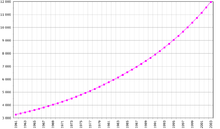- Demographics of Niger
-
This article is about the demographic features of the population of Niger, including population density, ethnicity, education level, health of the populace, economic status, religious affiliations and other aspects of the population.
The largest ethnic groups in Niger are the Hausa, who also constitute the major ethnic group in northern Nigeria, and the Zarma Songhay (also spelled Djerma-Songhai), who also are found in parts of Mali. Both groups are sedentary farmers who live in the arable, southern tier. The Kanouri (including Beri Beri, Manga) make up the majority of sedentary population in the far southeast of the nation. The remainder of the Nigerien people are nomadic or seminomadic livestock-raising peoples--Tuareg, Fulani, Toubou and Diffa Arabs. With rapidly growing populations and the consequent competition for meager natural resources, lifestyles of these two types of peoples have come increasingly into conflict in Niger in recent years.
Niger's high infant mortality rate is comparable to levels recorded in neighboring countries. However, the child mortality rate (deaths among children between the ages of 1 and 4) is exceptionally high (274 per 1,000) due to generally poor health conditions and inadequate nutrition for most of the country's children. Niger's very high fertility rate (7.4), nonetheless, means that nearly half (49%) of the Nigerien population is under age 15. School attendance is very low (34%), including 38% of males and only 27% of females. Additional education occurs through Koranic schools.
Contents
Core health indicators
World Health Organisation 2007 statistics: Core Health Indicators for Niger[1] Indicator Value (year) Life expectancy at birth (years) males 42.0 (2005) Life expectancy at birth (years) females 41.0 (2005) Healthy life expectancy (HALE) at birth (years) males 36.0 (2002) Healthy life expectancy (HALE) at birth (years) females 35.0 (2002) Probability of dying (per 1 000 population) between 15 and 60 years (adult mortality rate) males 502 (2005) Probability of dying (per 1 000 population) between 15 and 60 years (adult mortality rate) females 478 (2005) Total expenditure on health as percentage of gross domestic product 4.2 (2004) Per capita total expenditure on health at international dollar rate 25.9 (2004) Population (in thousands) total 13957 (2005) CIA World Factbook demographic statistics
The following demographic statistics are from the CIA World Factbook, unless otherwise indicated.[2]
Population
15,306,252 (July 2010 est.)
Age structure
0–14 years: 49.6% (male 3,840,379; female 3,758,674)
15–64 years: 48.1% (male 3,658,361; female 3,690,373)
65 years and over: 2.3% (male 159,984; female 198,481) (2010 est.)Population growth rate
3.643% (2011 est.)
Birth rate
51.6 births/1,000 population (2010 est.) Highest birth rate in the world.
Death rate
14.83 deaths/1,000 population (2010 est.)
Net migration rate
0 migrant(s)/1,000 population (2010 est.)
Sex ratio
at birth: 1.03 male(s)/female
under 15 years: 1.02 male(s)/female
15–64 years: 0.99 male(s)/female
65 years and over: 0.8 male(s)/female
total population: 1 male(s)/female (2010 est.)Infant mortality rate
total: 116.66 deaths/1,000 live births male: 121.72 deaths/1,000 live births female: 111.45 deaths/1,000 live births (2010 est.)
Life expectancy at birth
total population: 52.6 years
male: 51.39 years
female: 53.85 years (2010 est.)Total fertility rate
7.6 children born/woman (2011 est.) Highest fertility rate in the world.
Nationality
noun: Nigerien(s)
adjective: NigerienEthnic groups
Hausa 56%, Djerma 22%, Tuareg 8.5%, Fulani 8%, Beri (Kanouri) 4.3%, Arab, Toubou, and Gourmantche 1.2%, about 10,000 French expatriates
Religions
Muslim 80%, remainder indigenous beliefs and Christians (see Religion in Niger)
Languages
French (official), Hausa, Djerma, Tamajaq, Fulfulde.
Literacy
- Definition: age 15 and over can read and write
- Total population: 28.7% (2004 est.; source: UNDP 2006; NB- this figure is given without reference to which languages are considered)
- Male: 42.9%
- Female: 15.1%
See also
References
- ^ World Health Organisation 2007 statistics: Core Health Indicators for Niger.
- ^ [The World Factbook - Niger]
- UNDP. 2006. Beyond scarcity: Power, poverty and the global water crisis. Human Development Report 2006. New York: United Nations Development Programme (UNDP).
- UNDP The Human Development Index reports: Niger.
- Health Organisation Niger overview. Includes links to statistics, programs and news on health and demography in Niger.
- WHO "Country Logbook" for Niger. Providing Surveys, Censuses, Monitoring of vital events, Health services & surveillance, Health situation & trend analysis, and Planning & strategic documents .
- ethnologue.com: Ethnic and linguistic breakdown for Niger.
- OECD/ AEO 2007 Niger country study.
- The AGRHYMET Regional Centre (ARC), Niamey Office. Institute of the Permanent Interstate Committee for Drought Control in the Sahel (CILSS) composed of nine member States, including Niger.
- The World Bank, Niger overview and resources.
 Niger topics
Niger topics 
History Songhai Empire · Bornu Empire · Sultanate of Agadez · Sultanate of Damagaram · Dosso Kingdom · French West Africa · Tuareg RebellionPolitics Geography Economy and infrastructure Culture and society List of Niger-related topics Demographics of Africa Sovereign
states- Algeria
- Angola
- Benin
- Botswana
- Burkina Faso
- Burundi
- Cameroon
- Cape Verde
- Central African Republic
- Chad
- Comoros
- Democratic Republic of the Congo
- Republic of the Congo
- Côte d'Ivoire (Ivory Coast)
- Djibouti
- Egypt
- Equatorial Guinea
- Eritrea
- Ethiopia
- Gabon
- The Gambia
- Ghana
- Guinea
- Guinea-Bissau
- Kenya
- Lesotho
- Liberia
- Libya
- Madagascar
- Malawi
- Mali
- Mauritania
- Mauritius
- Morocco
- Mozambique
- Namibia
- Niger
- Nigeria
- Rwanda
- São Tomé and Príncipe
- Senegal
- Seychelles
- Sierra Leone
- Somalia
- South Africa
- South Sudan
- Sudan
- Swaziland
- Tanzania
- Togo
- Tunisia
- Uganda
- Zambia
- Zimbabwe
States with limited
recognition- Sahrawi Arab Democratic Republic
- Somaliland
Dependencies and
other territories- Canary Islands / Ceuta / Melilla / Plazas de soberanía (Spain)
- Madeira (Portugal)
- Mayotte / Réunion (France)
- Saint Helena / Ascension Island / Tristan da Cunha (United Kingdom)
- Western Sahara
Categories:- Demographics of Niger
- Nigerien society
Wikimedia Foundation. 2010.

